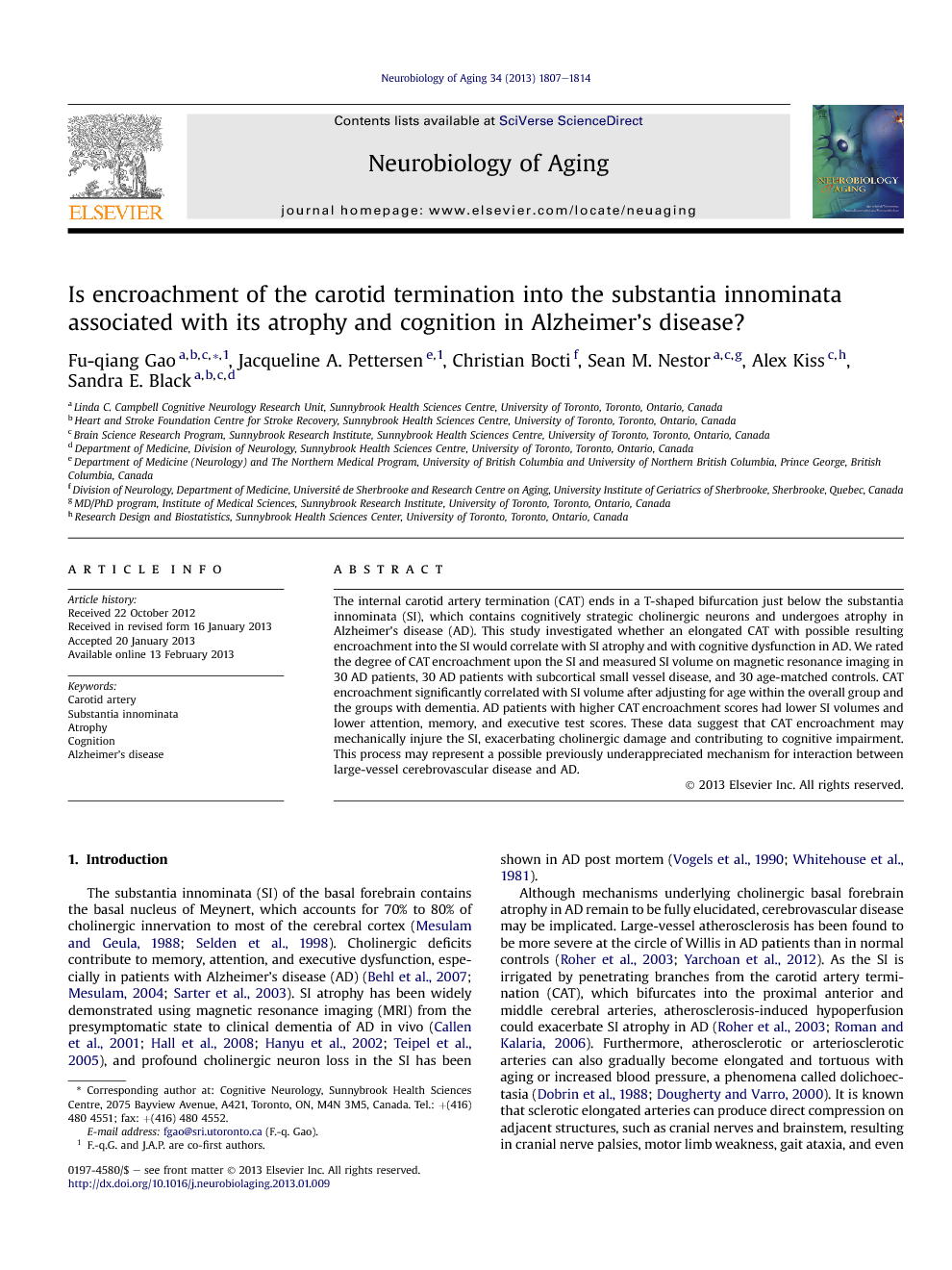The internal carotid artery termination (CAT) ends in a T-shaped bifurcation just below the substantia innominata (SI), which contains cognitively strategic cholinergic neurons and undergoes atrophy in Alzheimer's disease (AD). This study investigated whether an elongated CAT with possible resulting encroachment into the SI would correlate with SI atrophy and with cognitive dysfunction in AD. We rated the degree of CAT encroachment upon the SI and measured SI volume on magnetic resonance imaging in 30 AD patients, 30 AD patients with subcortical small vessel disease, and 30 age-matched controls. CAT encroachment significantly correlated with SI volume after adjusting for age within the overall group and the groups with dementia. AD patients with higher CAT encroachment scores had lower SI volumes and lower attention, memory, and executive test scores. These data suggest that CAT encroachment may mechanically injure the SI, exacerbating cholinergic damage and contributing to cognitive impairment. This process may represent a possible previously underappreciated mechanism for interaction between large-vessel cerebrovascular disease and AD.
The substantia innominata (SI) of the basal forebrain contains the basal nucleus of Meynert, which accounts for 70% to 80% of cholinergic innervation to most of the cerebral cortex (Mesulam and Geula, 1988; Selden et al., 1998). Cholinergic deficits contribute to memory, attention, and executive dysfunction, especially in patients with Alzheimer's disease (AD) (Behl et al., 2007; Mesulam, 2004; Sarter et al., 2003). SI atrophy has been widely demonstrated using magnetic resonance imaging (MRI) from the presymptomatic state to clinical dementia of AD in vivo (Callen et al., 2001; Hall et al., 2008; Hanyu et al., 2002; Teipel et al., 2005), and profound cholinergic neuron loss in the SI has been shown in AD post mortem (Vogels et al., 1990; Whitehouse et al., 1981).
Although mechanisms underlying cholinergic basal forebrain atrophy in AD remain to be fully elucidated, cerebrovascular disease may be implicated. Large-vessel atherosclerosis has been found to be more severe at the circle of Willis in AD patients than in normal controls (Roher et al., 2003; Yarchoan et al., 2012). As the SI is irrigated by penetrating branches from the carotid artery termination (CAT), which bifurcates into the proximal anterior and middle cerebral arteries, atherosclerosis-induced hypoperfusion could exacerbate SI atrophy in AD (Roher et al., 2003; Roman and Kalaria, 2006). Furthermore, atherosclerotic or arteriosclerotic arteries can also gradually become elongated and tortuous with aging or increased blood pressure, a phenomena called dolichoectasia (Dobrin et al., 1988; Dougherty and Varro, 2000). It is known that sclerotic elongated arteries can produce direct compression on adjacent structures, such as cranial nerves and brainstem, resulting in cranial nerve palsies, motor limb weakness, gait ataxia, and even obstructive hydrocephalus (Passero and Rossi, 2008; Smoker et al., 1986). The unique “T”-shaped CAT receives greater hemodynamic forces than the main artery even under normal circumstances (Foutrakis et al., 1999), and anatomically abuts the SI (Fig. 1). Thus, it is conceivable that an elongated CAT could gradually encroach upon the SI, eventually contributing to compressive SI atrophy.
Full-size image (24 K)
Fig. 1.
MRI (left) showing the spatial relationship between the carotid artery termination (CAT) and substantia innominata (SI). Corresponding Nissl-stained coronal section (right) of the left hemisphere of a post-mortem brain (with permission from deToledo-Morrell) at the level of the anterior commissure (AC) illustrates the SI (black outline), the region containing cholinergic neurons, lies right above the CAT, which bifurcates into the proximal anterior cerebral (ACA) and middle cerebral arteries (MCA). Abbreviations: ic, internal capsule; oc, optic chiasm; pt, putamen.
Figure options
In a previous MRI study of the limbic system in AD, we noticed incidentally that severe SI atrophy was often associated with encroachment by an elongated CAT (Callen et al., 2001). Our objective, therefore, was to assess possible relationships between degree of CAT encroachment and both SI volumes on MRI and cognition, in AD patients and age-matched controls. We hypothesized that increased CAT encroachment would correlate with decreased SI volumes and with lower cognitive performance, especially on attention, memory, and executive tasks, which appear to be selectively impaired with cholinergic dysfunction (Behl et al., 2007).


